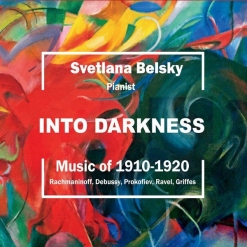Into Darkness: Music of 1910-1920 is a fascinating collection of classical solo piano music created before, during, and just after the First World War. Performed by Svetlana Belsky, the eleven pieces on the album were composed by Sergei Prokofiev, Claude Debussy, Sergei Rachmaninoff, Maurice Ravel, and Charles Tomlinson Griffes. As it so often does, music tells the story of its time far better than the words of historians. Emotions are clearly and often powerfully expressed in music that words just don't convey as well. Such is the case with this album. Presented in chronological order, the music demonstrates both the evolution of piano music as well as the mindset of the composers during this time of very dramatic change, tragedy and loss. Shortly after its release,
Into Darkness was selected as one of Spotify's Best Classical New Releases, and deservedly so!
Into Darkness begins the "Before the War (1910-1913) grouping with Prokofiev's "Prelude Opus 12 #7 ("The Harp"), composed when he was only nineteen and still a conservatory student. Joyful, fast and showy, it is by far the lightest and most optimistic piece on the album. One of his series of Preludes, Debussy's "Les collines d'Anacapri" is relaxed as it basks in the beauty of the island of Anacapri and the sparkling water all around it. Rachmaninoff's G Major Prelude, Op. 32 #5 is the third piece in the "before" section, and is a beautiful contrast to the powerful and stormy pieces that follow.
The "During the War (1914-1917)" section contains the six movements of Ravel's "Le Tombeau de Couperin," which was dedicated to fallen soldiers that were the composer's friends. The suite consists of a prelude, a fugue, three dances and a toccata, recalling the dance suites of Francois Couperin, but not composed in the Baroque style. There is a great deal of variety in each movement, and Belsky presents them with colorful expression and deep meaning.
The "After the War (1917-1919)" section consists of American composer Charles Tomlinson Griffes' three-movement Sonata, A.85. A powerhouse of turbulent, sometimes chaotic emotions, it's not a comfortable piece of music to listen to, but what an incredible expression of the horrors of war.
Born in the former Soviet Union, Svetlana Belsky received much of her music training in the US. She earned her Bachelor of Music Summa cum Laude and Master Degrees from the Peabody Conservatory of Music, and her Doctorate in Performance at the Manhattan School of Music. She served as the Director of the Piano Program at the University of Chicago for fifteen years and is now the Artistic Director for Sheridan Music Studio. She has toured in the Ukraine, Russia, Poland, Italy, Canada, China, Taiwan and Hong Kong, and throughout the United States. She was awarded the 2019 American Prize in Piano Performance and Silver Medals from the 2019 Global Music Awards. She also received the Outstanding Woman Award for Excellence in Music and Theater Arts by the Clerk of Cook County District Court to commemorate Women’s History Month in 2019. She has introduced compositions by no fewer than a dozen living composers.
A true work of art, Svetlana Belsky has assembled a very powerful musical statement with
Into Darkness: Music of 1910-1920. I hope the world will listen and take it to heart. The album is available from Amazon, Apple Music/iTunes, Spotify and other streaming sites. The CD is available from
SvetlanaBelsky.com.

